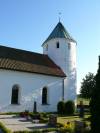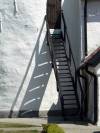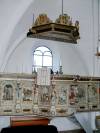Hammarlundas Kyrka
























































































Hammarlundas Kyrka
Where to find this church
Church Information
Hammarlundas Kyrka is located in Hammarlunda, a village in Skåne län in southern Sweden. Before the Reformation, it was dedicated to St Anna.
* denotes external links that open in a new window



Visiting Hammarlundas Kyrka
The church in Hammarlunda is one of the four Round Tower Churches in Skåne; unfortunately it is usually locked. But as I knew this before my visit, I had written to the parish so that I had a contact telephone number and someone unlocked the church for me. The village of Hammarlunda is situated on the Kävlingeån (Kävlinge River) and is on very old cultural soil. Many finds from the Stone Age testify to early settlement in the area. Hammarlunda is an old cult site and was named after the sacrificial grove (Swedish “offerlund”), which, it is assumed, was located on the hill about 300 metres west of the church.
Apparently, there were already church buildings here in the past: during an archaeological investigation in 1965, the remains of two older wooden churches were found, which stood on the same site as the present church: Hammarlunda I was built around 1050, but burnt down after a short time. Hammarlunda II was built around 1075 on the same site and according to the same construction method as Hammarlunda I. It was replaced by the present stone church.
This was built around 1150, probably by Mårten Stenmästare, one of the stonemasons of Lund Cathedral. It is built in the Romanesque style and originally had only three small windows and two entrances, a northern one for the women and a southern one for the men. In front of the southern portal, which is still in use, the atrium was built in the late Middle Ages. You can follow the development of the church building well in the last photo of the slideshow.
The tower was built at the same time as the church and is a defensive tower with eight embrasures and a single entrance three metres above the ground. Two stone tombs dating from the time the church was built were found under the floor of the tower room and are believed to be the final resting place of the builder and his family.
The vault of the tower room dates from the 13th century, while the other vaults were built in the 15th century.
The church at Hammarlunda is one of the few churches that still retain the old, almost unchanged medieval church interior. The baptismal font is the oldest fixture in the church. It dates from the same period as the church and was carved in one piece by Mårten Stenmästare. The insert for the font and the bowl for storing the baptismal water are made of brass and date from the 17th century.
The altarpiece was donated in 1589 by Count Henrik Brahe and his wife Lene Thott of the Löberöd manor. It used to consist of six panels with the words of institution of the Lord’s Supper in Danish, Latin and German. The present paintings were executed in the 18th century.
The pulpit is an outstanding work by the well-known Jakob Kremberg from Lund, and was donated in 1636 by Count Henrik Ramel, the owner of the Löberöd manor at the time. It was originally located at the triumphal arch. The sound lid bears the name of Christian IV and the Danish and Norwegian imperial coats of arms.
In the tower room are parts of the pulpit and the list of names (Series Pastorum) with the parish priests since 1350. In the vault hangs a chandelier made of ore and wood, which dates from the 18th century. Here also stands the so-called stick from the Middle Ages, whose use is similar to that of the pillory. The offertory candlestick was bought in 1993. The oldest church bells were from the 14th century and 1516 respectively. The present bells were cast in 1898 and 1924.
The church at Hammarlunda was dedicated to St. Anne. It was a well-known pilgrimage church for a long time. Many people came from far away to be cured of their illnesses. Even into the 20th century, many sought help from St. Anne of Hammarlunda.
Conclusion: beautiful church that is unfortunately locked



